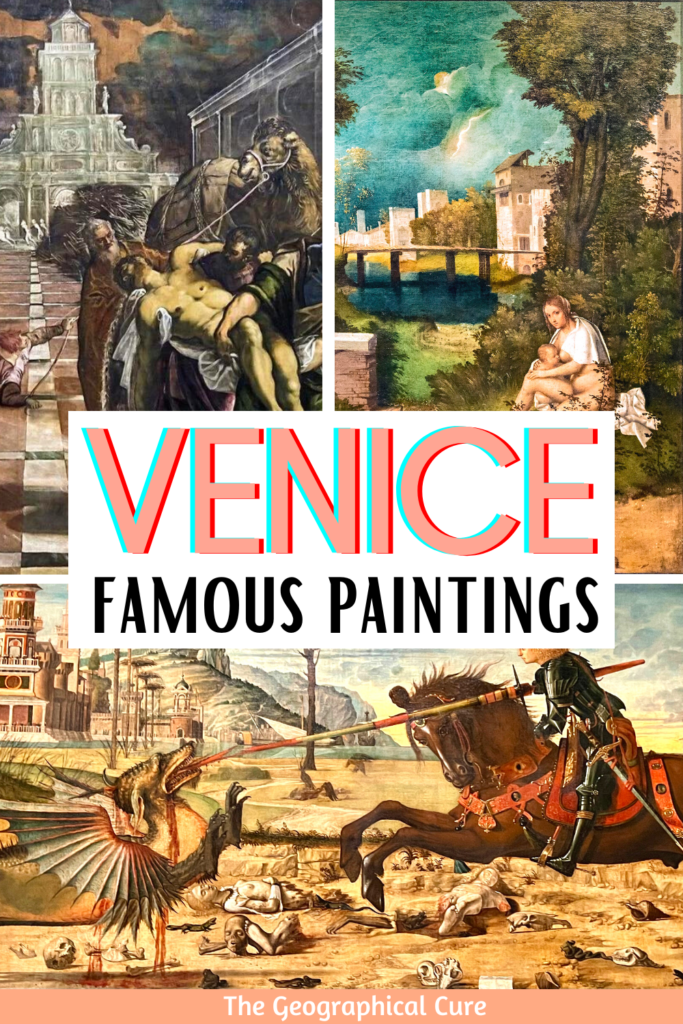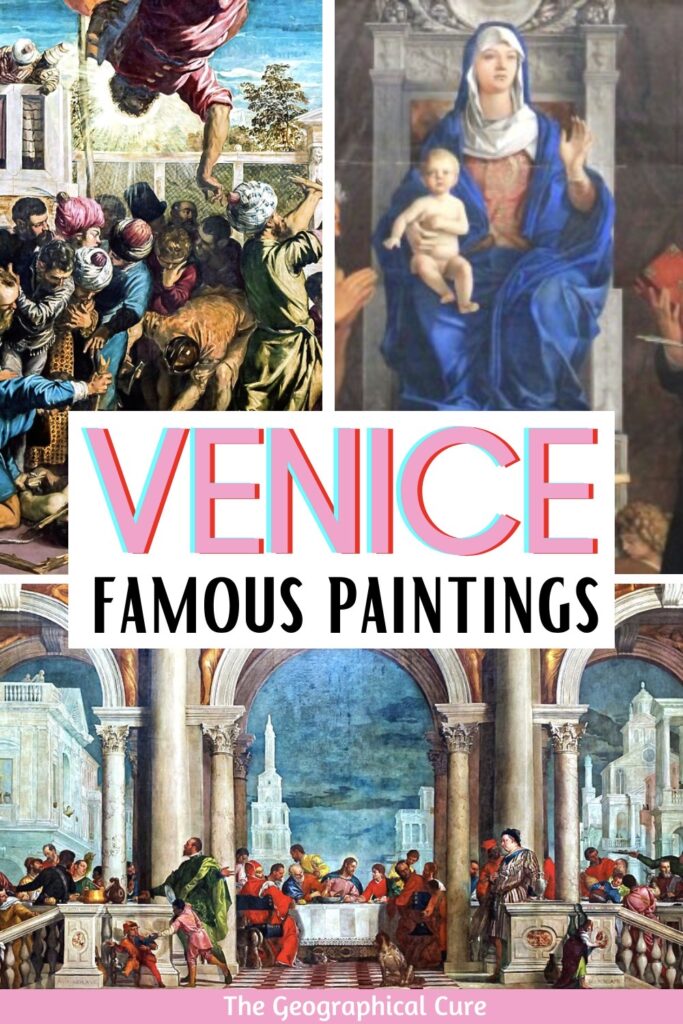Looking to discover the most famous paintings in Venice? You’ve come to the right place!
Venice, the glamorous city of canals and gondolas, has been a hub of art and culture for centuries. The city boasts some of the most famous paintings in Italy, and even in the world.
Venice has long been a source of inspiration for artists. Such greats as Titian, Bellini, Tintoretto, Mantegna, Giorgione, and Veronese worked and lived in Venice.
Venice is best known for its Renaissance masterpieces. Unlike painters in Florence, the Venetians used rich luminous colors and focused on lighting effects, embellishment, and sensual subject matter. They pioneered innovative and asymmetrical compositions.
But Venice is also home to some famous contemporary works, most notably in the Peggy Guggenheim Collection. It’s also home to the Venice Biennale, an international exhibition that has been showcasing contemporary art for centuries.
20+ Famous Paintings In Venice
Here are 21 must see paintings in Venice that should be on your art bucket list. I’ll also let you know where to find them in the city.
1. Veronese, Feast in the House of Levi
Veronese’s The Feast in the House of Levi is a hugely famous painting in Venice from the Italian Renaissance. It’s probably the most spectacular painting in the Galleria Accademia, in both quality and quantity.
Housed in Room 10, the painting is massive, 43 feet wide. Veronese’s subject was The Last Supper, the final meal among Jesus and his apostles before Jesus was betrayed by Judas.
READ: Last Supper Paintings of the Renaissance
The painting is famous for its monumental architecture, incredible detail, and utter chaos. The depiction is set in a massive triple arched loggia.
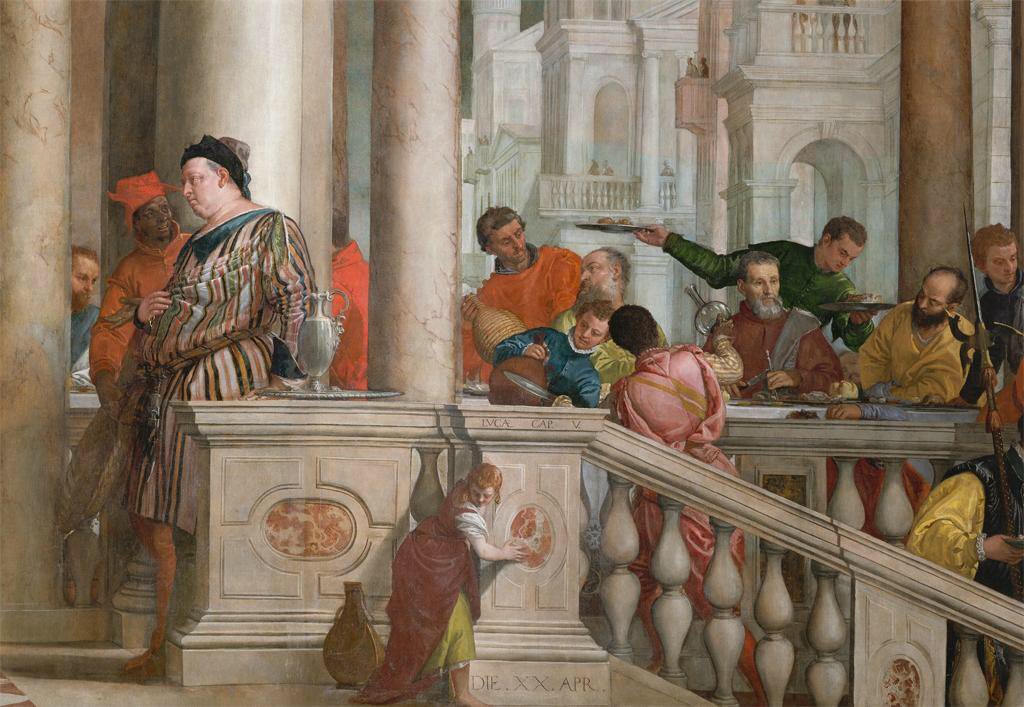
Veronese deemphasized the actual biblical meal in favor of hedonistic images. He painted an assortment of drunken characters, jesters, and other revelers. It’s more of a fantasy version of a patrician dinner party than an actual last supper painting.
Word got out about the racy and indecorous nature of Veronese’s last supper. The Inquisition censured Veronese for making a mockery of the holy meal. Religious images were supposed to have a certain propriety, after all.
As a result, Veronese was summoned to testify before the Inquisition. He refused to change any of the offensive details, citing artistic license. However, Veronese satisfied the Inquisition by simply changing the title of the painting.
Here’s my complete guide to visiting the Galleria Accademia. Click here to pre-book a ticket.
Where: Galleria Accademia
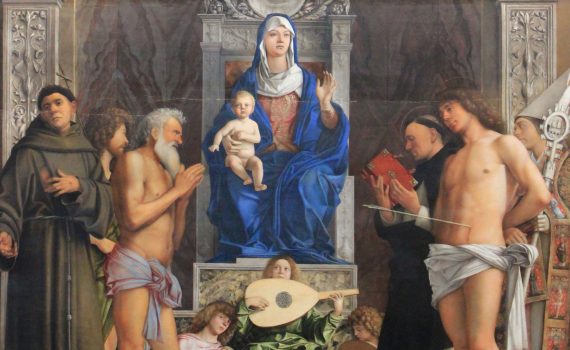
2. Bellini, St. Job Altarpiece
Bellini was the first great Venetian painter. His St. Job Altarpiece is generally considered to mark the first Renaissance moment in Venice.
The altarpiece was commissioned in 1479 by the Scuola di San Giovanni Evangelista for their chapel in the church of San Giovanni in Bragora. The painting depicts Saint Job, who was a popular figure of devotion in Venice, along with his wife and three friends.
The painting is a beautiful symmetrical arrangement of the Virgin Mary and the Christ child. Wingless angels play musical instruments. You see various saints — St. Francis of Assisi, St. John the Baptist, St. Job, St. Sebastian, St. Dominic, and St. Louis of Toulouse.
The real focus of the artist was to reproduce a mystical effect with the mosaics in the apse. It’s a call out to the mosaics of one Venice’s most important monuments, St. Mark’s Basilica.
Where: Galleria Academia
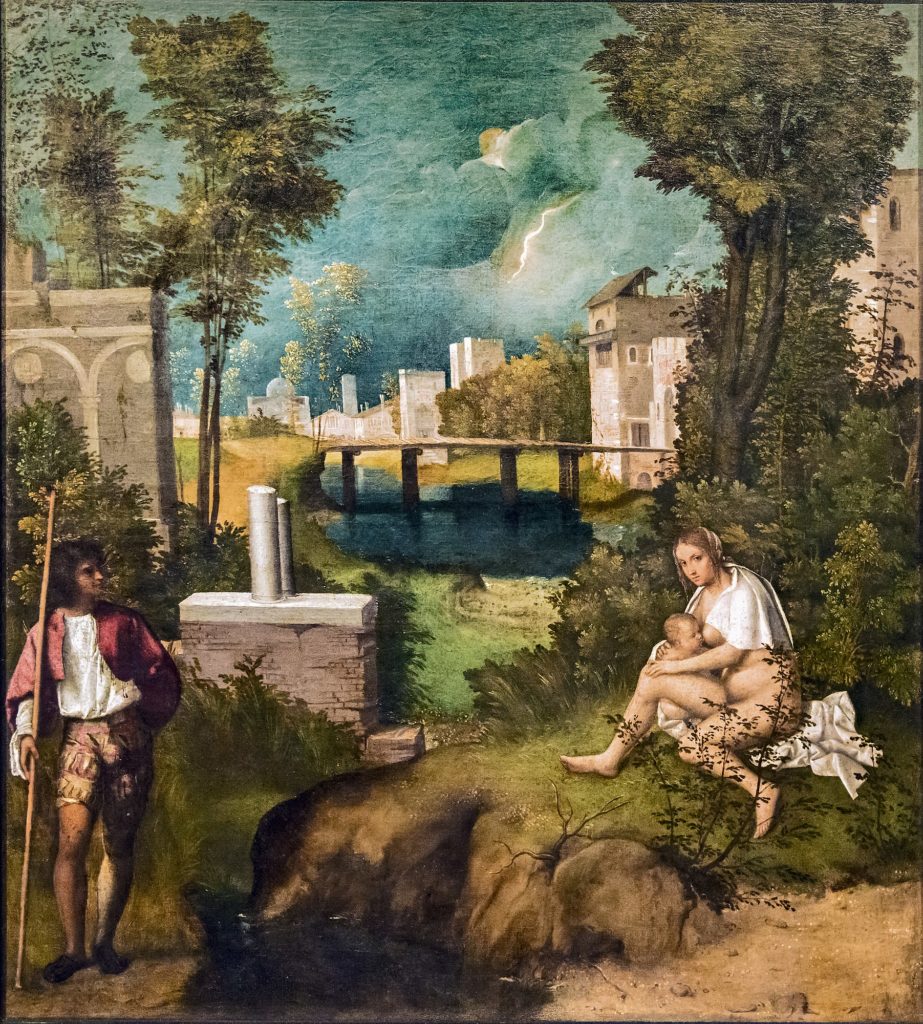
3. Giorgioni, The Tempest
Giorgione’s The Tempest is one of the most famous and controversial paintings in art history. Giorgione himself was an enigmatic figure. He only had a brief 15 year career before dying prematurely at the young age of 37.
When he unveiled The Tempest, people were puzzled by its unconventional subject matter. What was it depicting exactly? Initially, it was identified simply as a woman and a solider.
Some art historians argue that The Tempest is the first landscape in the history of Western painting. The setting is the lush countryside engulfed in a lightening storm.
The focal point of the painting is a nearly naked women. She looks out at the viewer, as if questioning your intrusion.
Others suggest Giorgione intentionally created a painting with no overt religious or moral subject. Instead, it was just a fantasy or capriccio (caprice). Still others suggest that The Tempest is Giorgione’s interpretation of the rest on the flight into Egypt from the Bible.
Where: Galleria Academia
4. Leonardo da Vinci, Vitruvian Man
The Vitruvian Man is arguably the most famous drawing on planet earth. The drawing was created during Leonardo’s stint as a court artist for Ludovico Sforza in Milan.
The drawing is not on permanent display because it’s too delicate and susceptible to fading. You’ll only see it at a special event at the Galleria Accademia.
What is the The Vitruvian Man exactly? It illustrates a principle set forth in an architectural treatise by Vitruvius. He asserted that the human body was the most perfect form and that this could be mathematically proven.
Some speculate that the Virtuvian Man is a self-portrait of Leonardo. At the bottom, you can see Leonardo’s writing in his famous right to left writing style.
READ: Guide To the Paintings of Leonardo da Vinci
Where: Galleria Academia
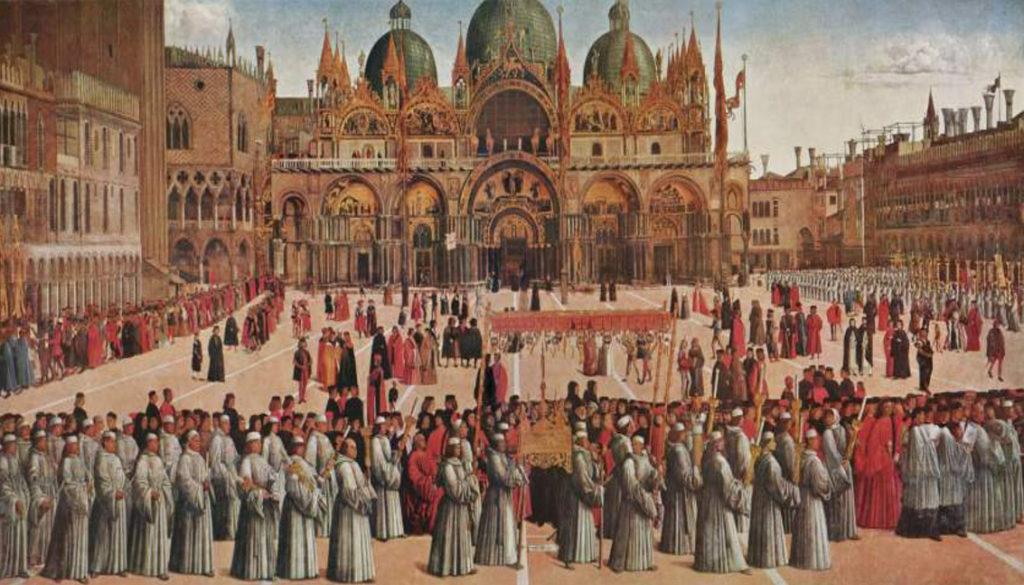
5. Gentile Bellini, The Procession In St. Mark’s Square
This Gentile Bellini painting depicts a miracle that occurred during a relic procession in Venice’s Piazza San Marco. The relic was Venice’s prize possession, a piece of the true cross on which Jesus was crucified.
The painting serves as a visual documentation of the city of Venice, like so much Venetian art of its time. The painting portrays St. Mark’s Square, over 500 years ago and before its 16th century makeover.
In the forefront of the painting, a merchant kneels in fervent prayer. Imbued with unwavering belief in the relic’s power, he prays for his son to survive a terrible accident. And he did.
Bellini also has another beautiful painting in the museum, the Recovery of the True Cross. This painting brings Venice to life as well. You can see how Venetians used their urban spaces and how they dressed.
Where: Galleria Academia
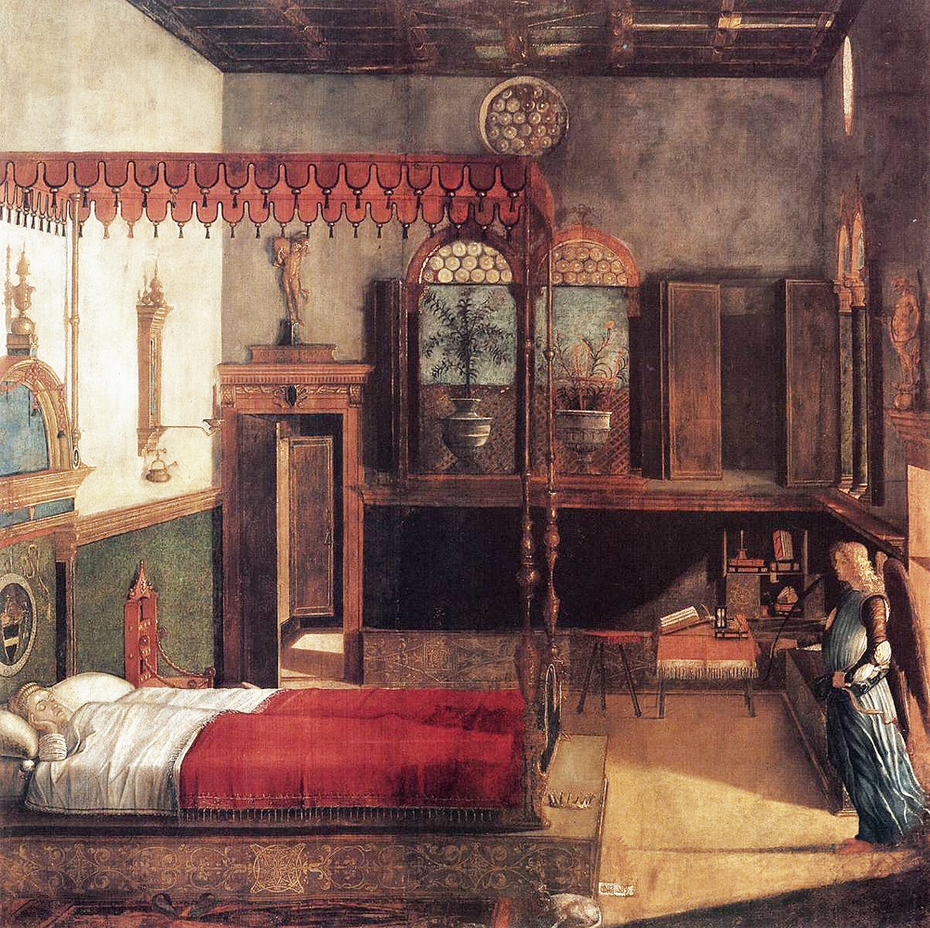
6. Carpaccio, St. Ursula Cycle
The Accademia also has a series of nine large Carpaccio canvases that make up the Saint Ursula cycle. The cycle has its own dedicated room (Room 21) in the Galleria Accademia, specifically designed for the paintings. They depict the story of Saint Ursula.
The cycle tells the story of Ursula, the daughter of a Christian king promised in marriage to a pagan prince. The paintings depict her betrothal, martyrdom, and apotheosis using a dream-like blend of reality and fantasy. The paintings all feature luxurious interiors and stunning panoramas of Venice.
The most famous painting in the cycle is the Dream of St. Ursula. It depicts Ursual sleeping while an angel bathed in light arrives to being her he palm of martyrdom. The angel’s message? Ursula will die for her faith.
The painting provides a rare glimpse into the interior of a wealthy Venetian home. The attention to detail is remarkable. You can see various elements of daily life, including the presence of books, which were a luxury item at the time.
Where: Galleria Academia
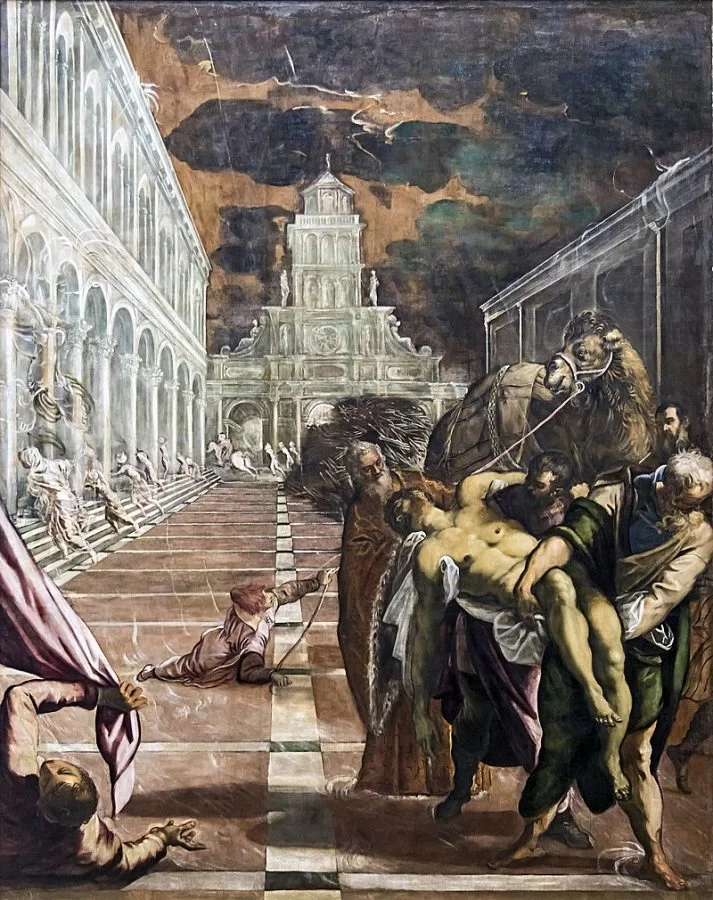
7. Tintoretto, St. Mark’s Body Brought to Venice
Venice’s theft of the body of Saint Mark is one of the most outrageous grave robberies in history. It was a daring act of swashbuckling kidnaping, carried out by two Venetian merchants in 829.
They goal was to steal or “rescue” St. Mark’s body from Alexandria Egypt and smuggle it back to Venice. They hid the corpse beneath piles of pork products in a gondola, so that Muslim officials would steer clear.
Tintoretto’s St. Mark’s Body interprets this historic theft in cinematic fashion. Tintoretto burst onto the scene in 1548, about 30 years after Giorgione.
Tintoretto was a pupil and rival of Titian. But Tintoretto was more avant garde, producing highly dramatic works more characteristic of the Mannerist paintings of the late Renaissance. The painting’s setting is supposed to be Alexandria. But it looks more like St. Mark’s Square.
The painting has a minimalistic background with a haunted sky. The central figures are displaced to the lower right corner, not the center. Tintoretto used to prime his canvases with black paint, giving them a dark and moody feel.
Where: Galleria Academia
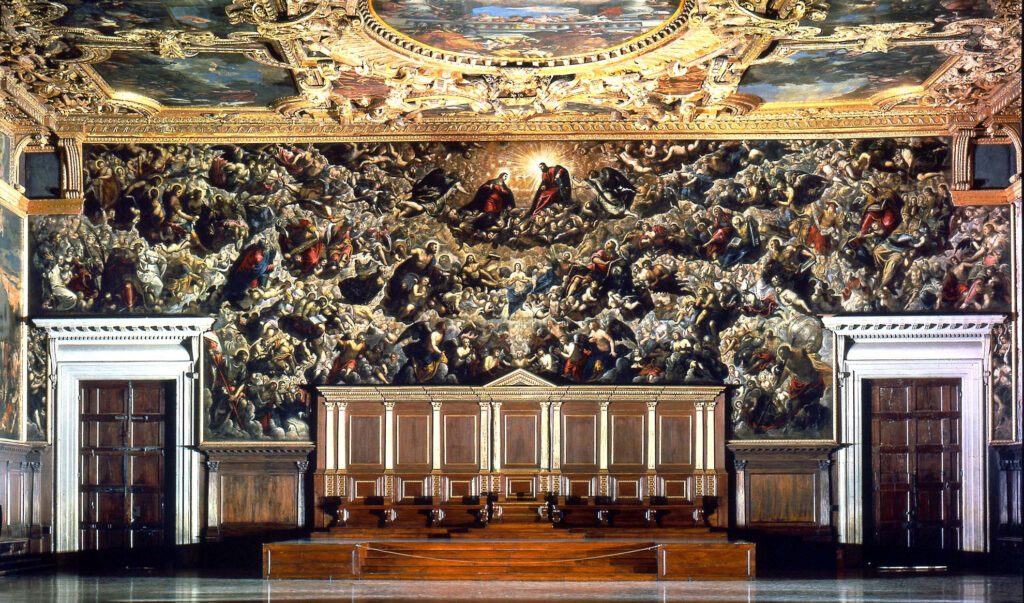
8. Tintoretto, Il Paradiso
ll Paradiso is another famous painting in Venice by Tintoretto. It’s one of the largest paintings in the world and considered one of the greatest masterpieces of the Venetian Renaissance. Art critic John Ruskin described it as “by far the most precious work of art of any kind whatsoever.”
The painting was commissioned in the late 16th century by the Venetian government to decorate the ceiling of the Great Council Hall in the Doge’s Palace, which is the main reception room. Tintoretto slaved away on it for 7 years.
Il Paradiso depicts a scene in heaven with over 500 figures. Set against a blue sky, angels, saints, and cherubs ares gathered around a light representing divinity.
Visitors to the palace can admire this painting and so much more. Click here to pre-book a ticket to the Doge’s palace. For more information, you can check out my guide to the Doge’s Palace.
Where: Doge’s Palace
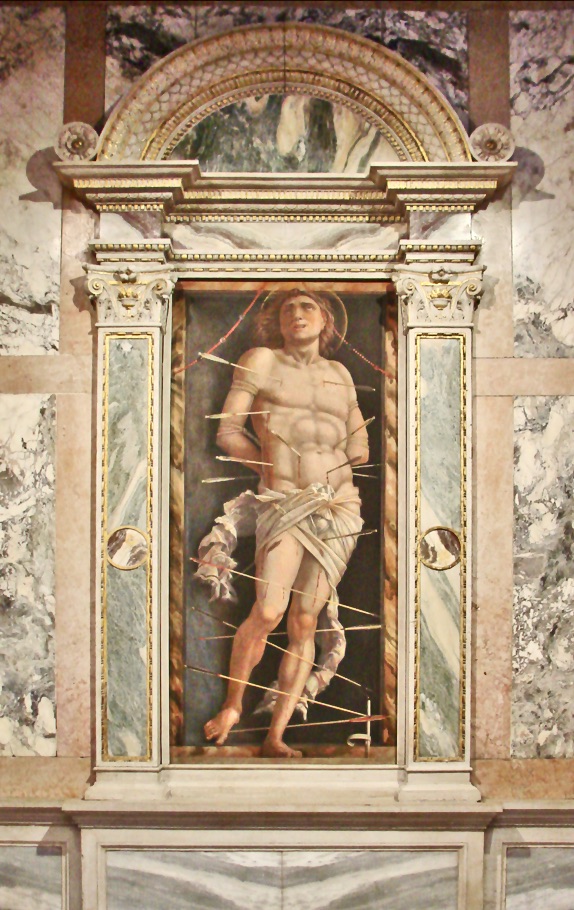
9. Mantegna, St.Sebastian, Ca d’Oro
St. Sebastian is another famous painting in Venice by the Renaissance artist Andre Mantegna. The artist bridged the Early and High Renaissance periods. He was a pioneer of spatial illusionism and had a perfectionist love of detail.
This Mantegna painting depicts the Christian martyr Saint Sebastian. He’s in the usual position — tied to a tree and shot with arrows.
In Mantegna’s interpretation, the saint is shown in a dramatic post. His arms are tied behind his back and his head is thrown back in agony.
The painting is notable for Mantegna’s skillful use of perspective and realism. In the background is a lush forested landscape.
The painting was commissioned by the powerful Gonzaga family of Mantua. It’s considered a Renaissance masterpiece and should definitely be on your Venice art bucket list.
Click here to book a ticket to Ca’ d’Oro Franchetti Gallery, where the painting is housed.
Where: Ca’ d’Oro
10. Klimt, Judith II
The underrated International Gallery of Modern Art in Ca’ Pesaro houses an unusual painting in Venice, Gustav’s Klimt’s glittering Judith II. It’s also known as Salome.
Klimt is Austria’s most famous painter, renowned for his intoxicating and sensual Art Nouveau portraits of women.
Judith II is based on the famous bible story where Judith decapitates a general, Holofernes, to save her city. This theme was popular among Renaissance and Baroque artists like Caravaggio.
In this version of the Judith, Klimt portrays her in vivid sexualized detail with a sensuous face and bejeweled claw-like hands. There’s a riot of contrasting colors and a background of shimmering gold, typical of Klimt’s golden phase.
Where: Ca’ Pesaro, Galleria Internazionale d’Arte Moderna
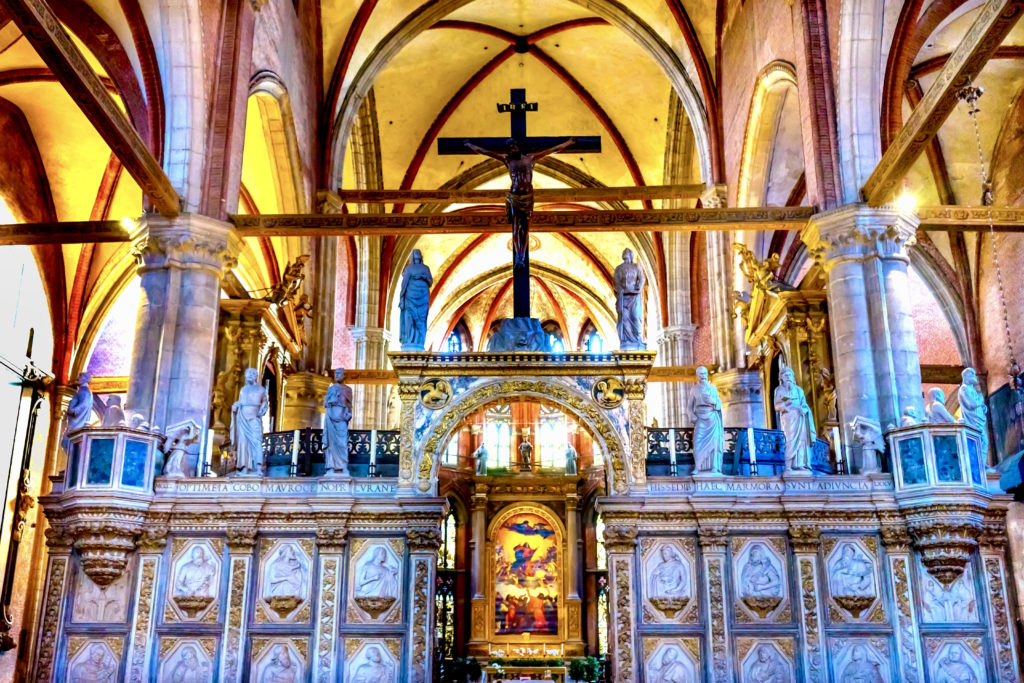
11. Titian, Assumption of the Virgin
This is the most important painting in Venice’s art-filled Frari Church. It’s Titian’s Assumption and can be viewed through a semi-circular opening in the rood screen as you walk down the nave.
This huge painting, 20 x 11 feet, was Titian’s first public work. He was only in his late 20s when he executed it. The Assumption established him as the foremost painter in Venice.
The story of the Assumption is based on the belief that Mary didn’t die, but just fell into a divine sleep. She’s awoken by God and her body is pulled into heaven.
Most Renaissance-era assumption paintings depict a rather static image of an empty sarcophagus with Mary hovering above it. Titian’s piece, in contrast, is a drama-filled scene filled with light and color.
The painting is divided into two levels. On the lower level, the apostles gather around a tomb, gazing up at Mary as she is assumed. On the upper level, you see a radiant Mary in a cloud-filled sky supported by angels. Mary looks a tad sensual. The drapery of her cloths is blowing in the wind.
It’s thought that Raphael’s famous 1520 Transfiguration in the Vatican Picacoteca was heavily influenced by Titian’s Assumption. In turn, Titian may have been influenced by Raphael’s Sistine Madonna from 1512.
Where: Basilica di Santa Maria Gloriosa dei Frari
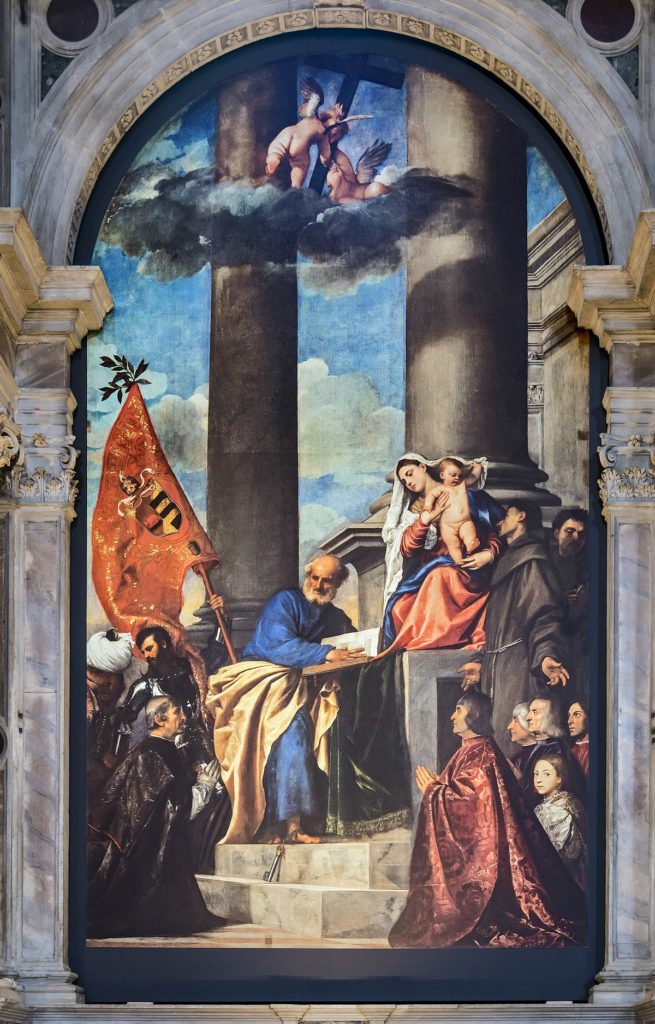
12. Titian, Pesaro Madonna
Unveiled in 1518, Titian’s Pesaro Altarpiece is a famous painting in Venice depicting Mary with Christ and the saints. The piece was commissioned by one of Venice’s most prestigious citizens, Jacopo Pesaro. And it’s found in the family’s Pesaro Chapel in the Frari Church.
In the painting, Pesaro kneels before Mary, who is placed daringly off-center. Titian’s wife posed as Mary.
Behind Pesaro is a knight holding the Papal and Pesaro coat of arms, symbolizing Pesaro’s victory over the Turks. St. Peter is depicted in a toga with white hair and a beard. You know it’s him because his “keys to the kingdom” dangle.
On the other side is St. Francis of Assisi, shown in his usual brown habit. He presents members of the Pesaro family to Mary for her blessing. The whole scene is set a classical environment, with monolithic columns suggesting Olympia above.
This painting scandalized the citizens of Venice, who were used to more subdued church art. The rich colors and twisting poses seemed bold.
Most strikingly, Mary is depicted as fully human, rather than a stiff icon on a throne. Only after the Holy Roman Emperor offered to buy the altarpiece did the church finally agree to pay Titian for the art work.
Where: Basilica di Santa Maria Gloriosa dei Frari
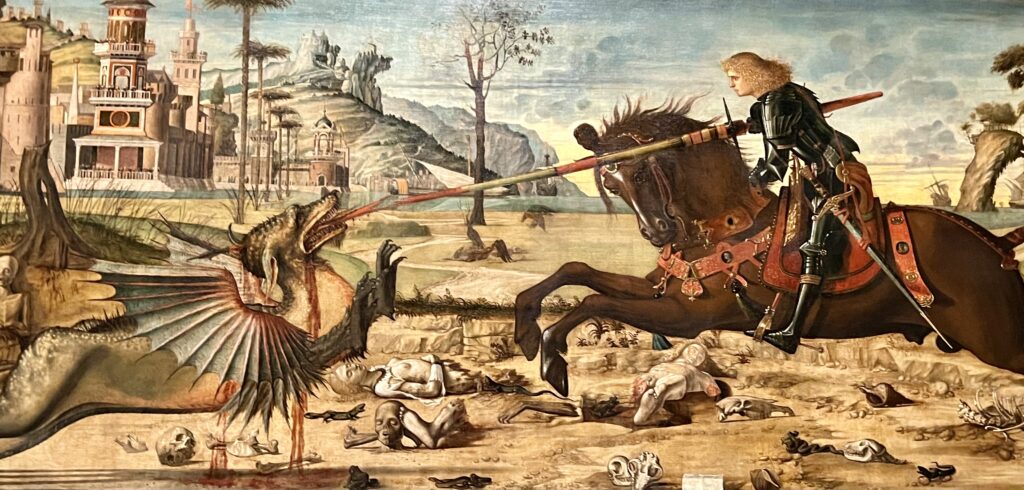
13. Carpaccio, St. George and the Dragon
Carpaccio’s St George and the Dragon is another famous painting in Venice, housed in the Scuola di San Giogio degli Schiavoni.
The painting is located in the Sala del”Albergo and is one of Carpaccio’s largest canvases. It’s a masterpiece of vibrant color, dramatic composition, and intricate details.
It depicts St. George, the patron saint of the scuola, as a young knight dressed in armor. He’s slaying a fierce dragon, depicted as a monstrous creature, that’s been terrorizing the city of Sielen.
The beautiful painting reflects the obsession in Venice with the concepts of heroism and chivalry. It’s rich in detail, filled with symbolic elements, and the landscape is carefully rendered.
Where: Scuola di San Giogio degli Schiavoni
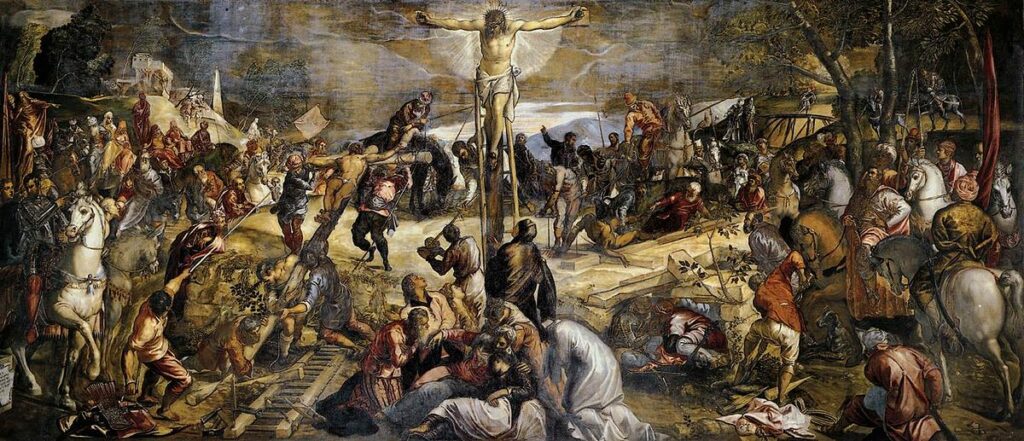
14. Tintoretto, Crucifixion
The Scuola Grande di San Rocco is an amazing space, decorated wall to wall by Venetian Renaissance painter Tintoretto.
His fresco cycle in the Chapter Room is considered the “Sistine Chapel of Venice.” Tintoretto spent the last two decades of his life slaving away on this endeavor. Handheld mirrors allow you to see the ceiling paintings without neck strain.
The most famous work in the scuola is the colossal Crucifixion, which covers the entire wall behind the altar in the Albergo. Christ is show in agony on the cross, while mourners and soldiers look on from below.
The scene is rendered in Tintoretto’s signature dramatic style, with exaggerated perspectives, bold brushstrokes, and strong contrasts of light and dark.
Where: Scuola Grande San Rocco
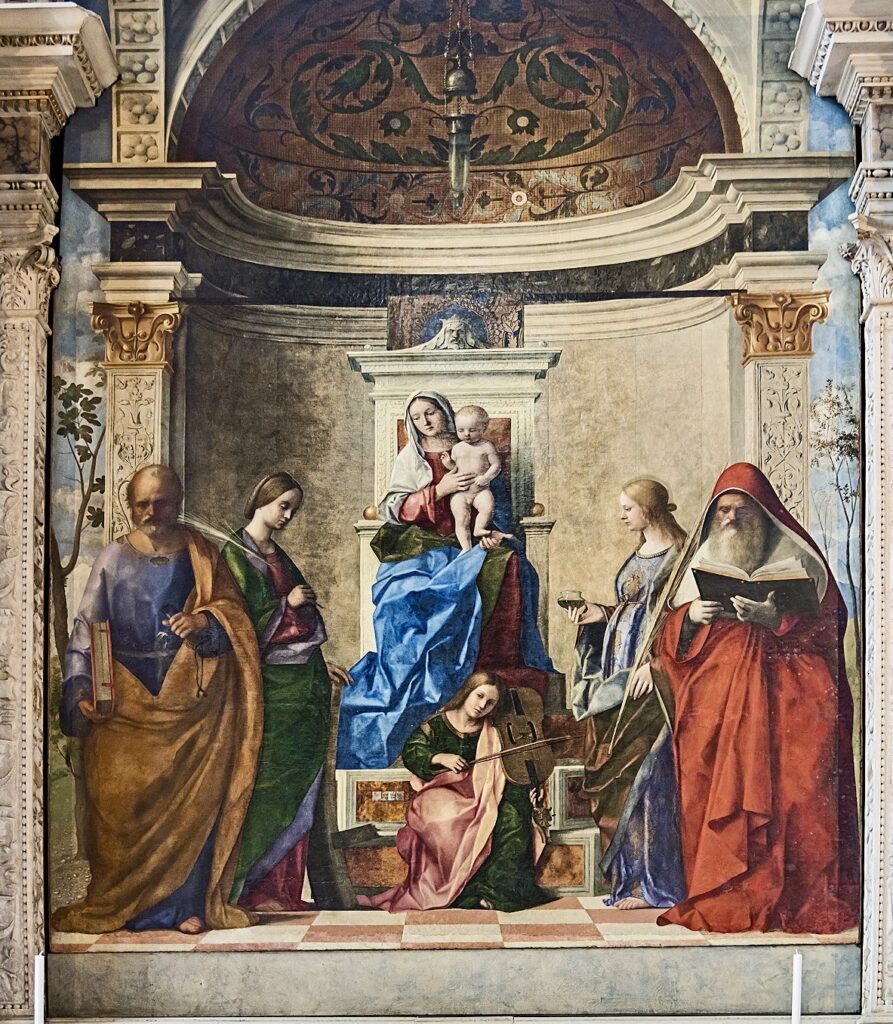
15. Bellini, Madonna Enthroned with Child and Saints
Bellini’s Madonna Enthroned is one of the most famous paintings in Venice and a masterpiece of the Italian Renaissance. The painting was commissioned by the Scuoloa Grande di San Marco in 1487 and is the San Zaccaria Church.
It’s a typical representation of the Madonna enthroned theme. Mary is shown sitting on a throne, with the Christ baby in her lap.
One of the most interesting features of the painting is the use of gold leaf. It gives the painting a luminous quality and underscores the sense of grandeur and majesty of the figures.
Where: Church of San Zaccaria
16. Jackson Pollock, Alchemy
Alchemy is a famous painting in Venice by American Abstract Expressionist Jackson Pollock. It’s housed in the Peggy Guggenheim Collection, which is the single greatest museum of 20th century art in Italy. Guggenheim was a patron of Pollock and helped launch his career.
The painting is an example of Pollock’s signature “drip painting” style, which involves pouring and dripping paint onto a canvas laid out on the floor.
Alchemy is quite large, measuring 4 x 8 feet. It’s mostly composed of thick black lines and drops of paint, with occasional patches of red, white, and gray. The effect is an intricate web, with a sense of movement and dynamism.
It’s unclear what the painting means. It seems as if day and night are depicted on the same canvas.
Some art historians see it as representing the violence of a post WWII world. Others claim it is a mystical celebration of human creatively.
Here’s my complete guide to the Guggenheim Collection. Click here to purchase a ticket to the Guggenheim Collection. Click here to book a private guided tour.
Where: Peggy Guggenheim Collection
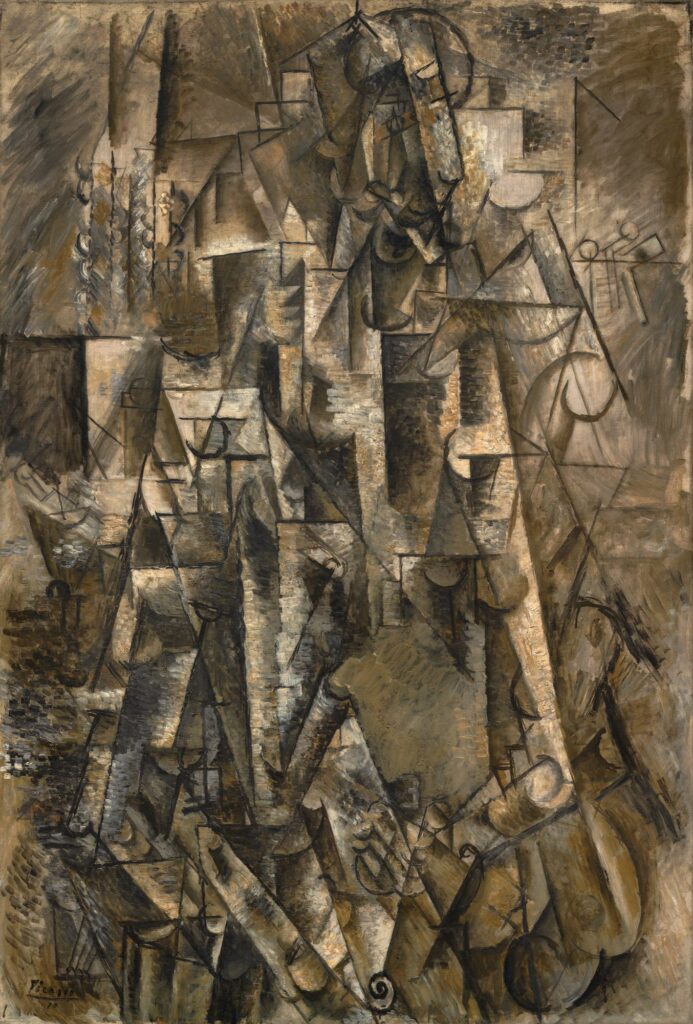
17. Pablo Picasso, The Poet
The Poet is a painting by Pablo Picasso that’s the epitome of Analytical Cubism’s most extreme abstraction. In this oeuvre, objects are rendered nearly unrecognizable.
The poet features a pyramidal figure that is engulfed and broken down in lines, geometric planes, shadow, and hatched brushstrokes.
The palette is chromatic, as is typical of this period of Cubism. The overall effect is a figure in content flux.
Where: Peggy Guggenheim Collection
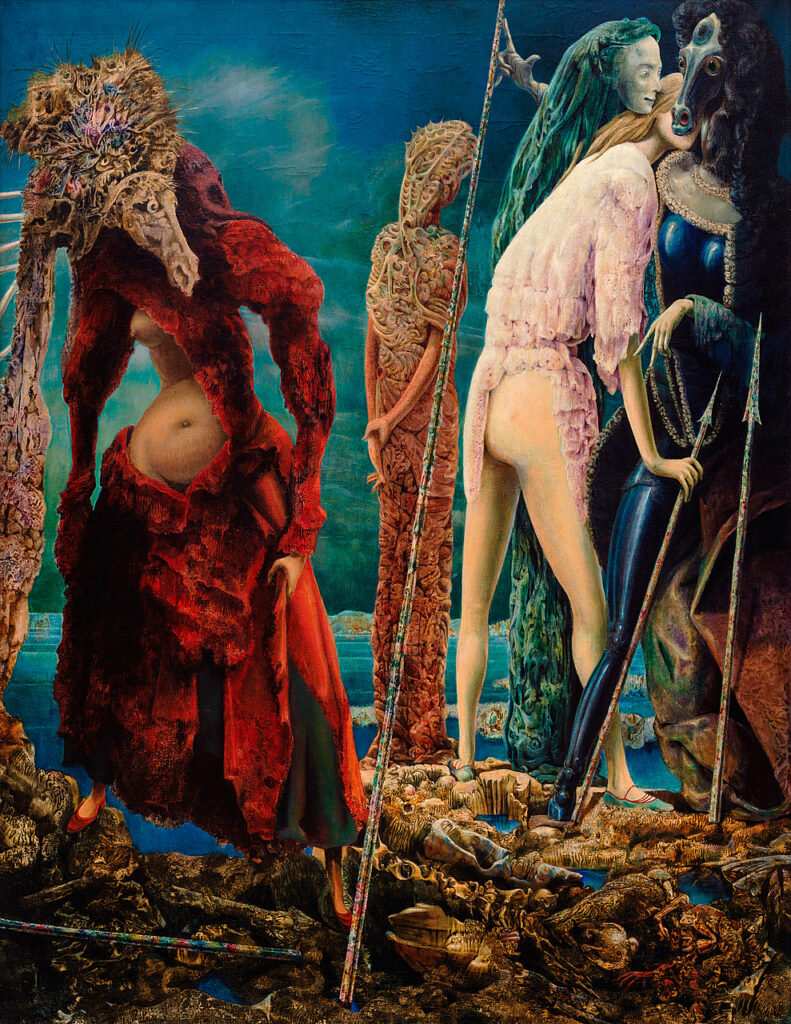
18. Max Ernist, The Antipope
Max Ernst’s The Antipope is a surrealistic painting in Venice created in 1941. The painting depicts a group of five hybrid figures in a surrealistic landscape, with strange and fantastical imagery.
The main figure is a woman with a face that looks like a horse. She is flanked by four figures on the right. The women in the painting are said to represent different aspects of the artist’s turbulent love life.
The background of the painting is dark and diffuse. The overall effect of the painting is dreamlike and unsettling, with a sense of mystery and ambiguity that is characteristic of Ernst’s work.
Who is the antipope figure? The identity remains a mystery. But art historians speculate that it could be a self-portrait or a portrait of Guggenheim, who was his patron and wife for a time.
Where: Peggy Guggenheim Collection
19. Ca’ Grassi, Pinault Collection
There is no single famous painting in Venice at the Ca’ Grassi. Rather, the museum’s goal is not to have a standard permanent collection.
Instead, what you’ll see on a visit are ever-rotating pieces from the contemporary art collection of French billionaire Francois Pinault.
He made his mega fortune with luxury fashions like as Gucci, Bottega Veneta, Saint Laurent, and Balenciaga. He also owns the auction house Christie’s.
Pinault’s all-star collection includes post-1960 works by notable artists such as Cy Twombly, Cindy Sherman, Damien Hirst, Jeff Koons, and some 400 others. Along with these established artists, he also collects works by local artists, emerging artists, and iconoclastic artists.
You can also find pieces from the Pinault collection in the Punta Della Dogana.
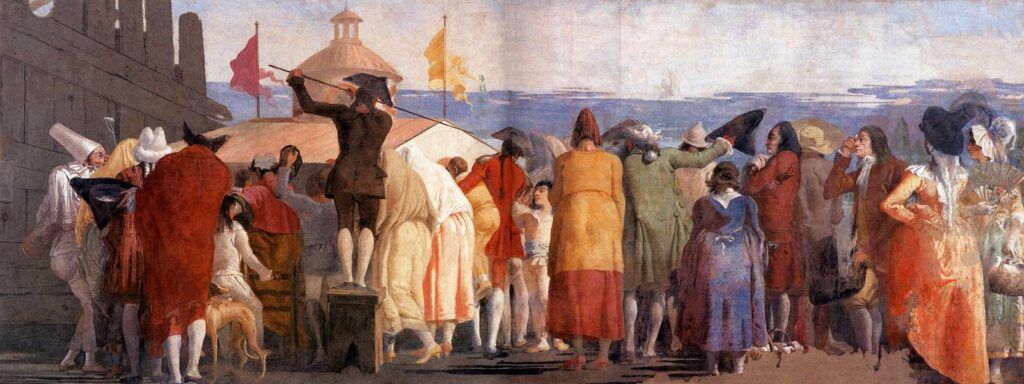
20. Giandomenico Tiepolo, New World
In Ca’ Rezzonico, the Museum of 18th Century Art, you’ll find a delightful cycle of frescoes by Giandomenico Tiepolo, the son of the more renowned artist. The works weren’t intended for public display, but were created solely for the enjoyment of the family. These frescoes are the artist’s final and most significant accomplishment.
The frescoes depict Punchinello stories, scenes depicting villa life, and playful games. They effectively capture a cultural snapshot of late 18th-century Venice.
One of the central pieces, titled New World, is a must see masterpiece in Venice. It presents a gathering of country residents and nobility who cluster around a showman operating a booth with a magic lantern. They’re depicted from the rear.
The work is essentially an anti-portrait. The faces of the figures are obscured and even the very spectacle they’re observing kept hidden. On the left side, a curious Punchinello figure can be observed, holding a pitchfork. This deliberate ambiguity lends the painting a perplexing yet enchanting quality.
Where: Ca’ Rezzonico
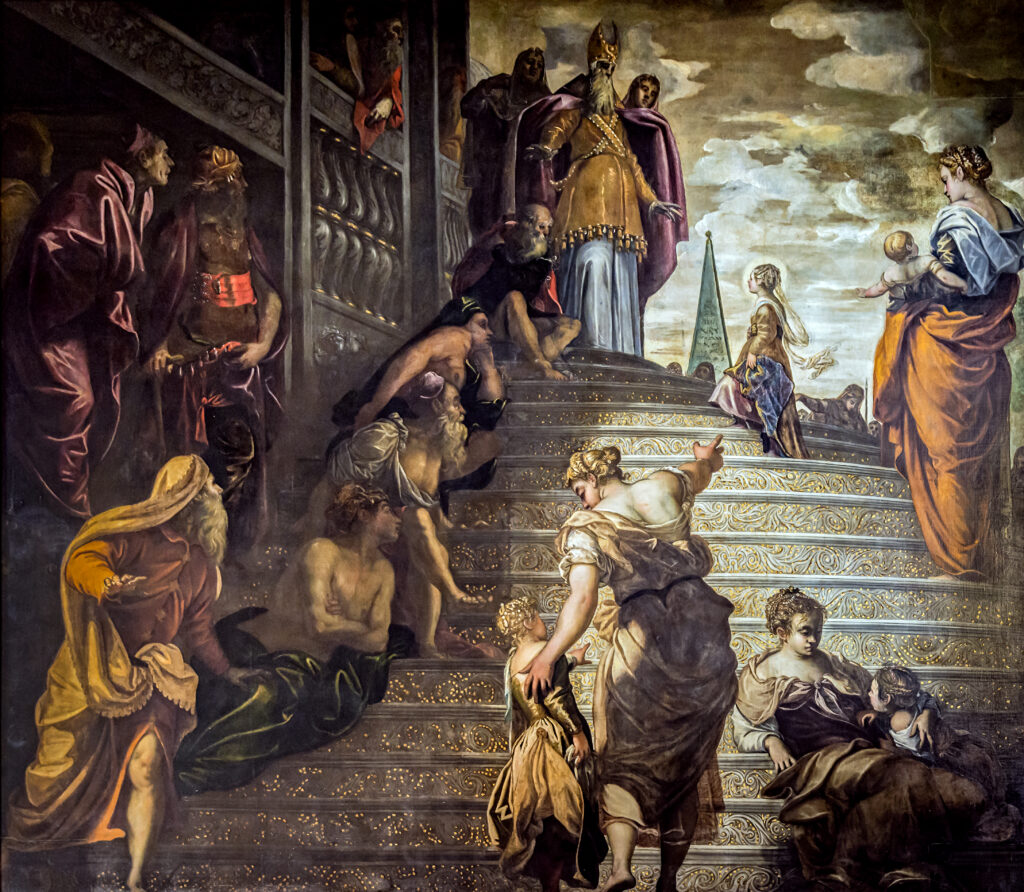
21. Tintoretto, Presentation of the Virgin
The Church of Madonna dell’Orto is famous for a collection of works by Tintoretto, who was also a church parishioner. His most famous work there is the Presentation of the Virgin in the Temple.
The painting depicts the moment when the parents of the Virgin Mary present her to the high priest of the temple. Mary is dressed in rich costume and a halo frames her head.
The temple priests look on in reverence. The gold tones of the temple and steps create a sense of warmth and radiance in the scene.
The painting is located on the high altar of the church and is considered one of the most famous paintings in Venice.
Where: Madonna dell’Orto Church
I hope you’ve enjoyed my guide to the most famous paintings in Venice. You may enjoy these other Italy travel guides and resources:
- 2 days in Venice itinerary
- 3 days in Rome itinerary
- 3 days in Florence itinerary
- 10 day itinerary for Tuscany
- 10 day itinerary for Italy’s classic cites
- 12 ways to spend 1 week in Italy
- 10 day itinerary from Milan to Rome
- 1 week itinerary from Venice to Milan
- 30 beautiful towns in Italy
- 100+ Italy bucket list experiences
- Tips for visiting Italy
- Historic landmarks in Italy
If you want to check these famous paintings off your Venice bucket list, pin it for later.

